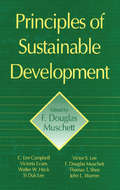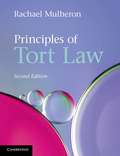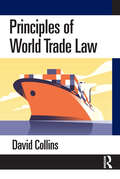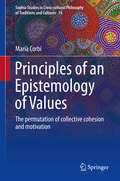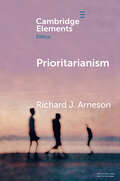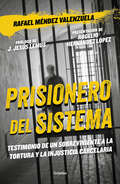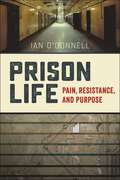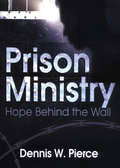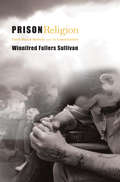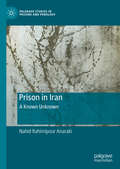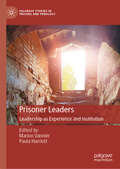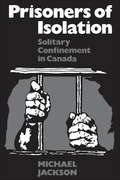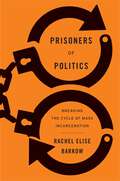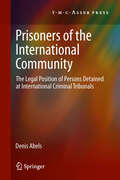- Table View
- List View
Principles of Sustainable Development
by F. Douglas MuschettThis book brings together the collective thinking, ecological perspectives, and experiences of individuals from air quality, land use and transportation disciplines who are working to advance and operationalize sustainable development.
Principles of Taxation for Business and Investment Planning (2017 Edition)
by Shelley Rhoades-Catanach Sally M. JonesPrinciples of Taxation for Business and Investment Planning focuses on the role taxes play in business and investment decision, presenting the general roles of taxation and discussing its implications for all tax-paying entities before delving into a specific exception. The benefit of this approach is a strong grasp of the fundamental principles informing taxation rules. This helps students comprehend the framework of the tax system, making future changes to the tax code easier to understand-no matter how many there are. Unlike traditional introductory texts, Principles of Taxation for Business and Investment Planning downplays the technical detail that makes the study of taxation such a nightmare for business students. This text attempts to convince students that an understanding of taxation is not only relevant but critical to their success in the business world. Don't just teach your students the tax code; teach them how the tax code affects business decision making with the 2017 edition!
Principles of Tort Law
by Rachael MulheronPresenting the law of tort as a body of principles, this authoritative textbook leads students to an incisive and clear understanding of the subject. Each tort is carefully structured and examined within a consistent analytical framework that guides students through its preconditions, elements, defences and remedies. Clear summaries and comparisons accompany the detailed exposition, and further support is provided by numerous diagrams and tables, which clarify complex aspects of the law. Critical discussion of legal judgments encourages students to develop strong analytical and case-reading skills, whilst key reform proposals and leading cases from other jurisdictions illustrate different potential solutions to conundrums in tort law. A rich companion website, featuring ten additional chapters and sections on more advanced areas of tort law, completes the learning package. Written specifically for students, the text is also ideal for practitioners, litigants, policymakers and law reformers seeking a comprehensive and accurate understanding of the law.
Principles of Tort Law
by Rachael MulheronPresenting the law of tort as a body of principles, this authoritative textbook gives an incisive understanding of the subject. Each tort is carefully structured and examined within a consistent analytical framework that guides students through its preconditions, elements, defences and remedies. Clear summaries and comparisons accompany the detailed exposition, and further support is provided by diagrams and tables which clarify complex aspects of the law. Critical discussion of legal judgments encourages students to develop strong analytical and case-reading skills, whilst key reform proposals and leading cases from other jurisdictions illustrate different potential solutions to conundrums in tort law. A rich companion website, featuring semesterly updates alongside ten additional chapters on more advanced topics, completes the learning package. This new edition has been updated to take account of important cases, legislative developments and law reform studies since July 2015.
Principles of Water Law and Administration: National and International, 3rd Edition
by Dante A. Caponera Marcella NanniThis book, which was first published in 1992 and then updated in 2007, provides a tool for dealing with the legal and institutional aspects of water resources management within national contexts and at the level of transboundary water resources. Like its two previous editions, it seeks to cover all aspects that need to be known in order to attain good water governance, but it provides updates concerning developments since 2007. These relate, inter alia, to the following: - the “greening” of water law, which calls for the progressive integration of environmental law principles into domestic and international water law; - the adoption, by the International Law Commission in 2008, of the Draft Articles on the Law of Transboundary Aquifers, and subsequent developments;- the emergence of the right to water as a self-standing human right;- the adoption of domestic water laws supporting integrated water resources management (IWRM) and enhanced public participation in planning and decision making;- the integration into these laws of tools facilitating adaptive water management as a response to climate variability and change;- progress in the implementation of EU law;- recent international agreements and judicial decisions;- efforts of regional organizations other than the EU to steer cooperation in the management of transboundary water resources and the harmonization of national laws;- institutional mechanisms for the management of transboundary water resources (surface and underground). Unique in its scope and nature, the book identifies the legal and institutional issues arising in connection with water resources management and provides guidelines for possible solutions in a manner accessible to a wide range of readers. Thus, it is a useful reference for lawyers and non-lawyers — engineers, hydrologists, hydrogeologists, economists, sociologists — dealing with water resources within government institutions, river basin commissions, international organizations, financing institutions and academic institutions, among other things, and also for students of disciplines related to water resources.
Principles of World Trade Law
by David CollinsPrinciples of World Trade Law presents a comprehensive and balanced picture of the legal framework underpinning the modern world trading system – covering the law of the WTO but also drawing on bilateral and regional instruments. It acknowledges the shifting relevance of the WTO in world trade law in favour of regionalism, particularly in relation to new fields such as digital trade.While drawing heavily on the law of the WTO as a source of legal rules, this concise text also engages with elements found in preferential Free Trade Agreements (FTAs) (such as Rules of Origin) and mutual recognition agreements (such as recognition of professional qualifications in the case of services). Practical in nature, it blends straightforward descriptive explanations of the legal concepts with critical inquiry, directing readers to the key debates in the field as well as the source materials themselves. It also offers guidance with discussion questions for the reader to consider for each chapter.Principles of World Trade Law is an ideal introductory textbook for advanced undergraduate and postgraduate students taking courses in world trade law, international trade law, and international economic law as well as a valuable guide for scholars, legal practitioners and policymakers.
Principles of an Epistemology of Values
by Marià CorbíThis book addresses the need to create an "axiological epistemology". This term refers to knowledge of what is axiological, i. e. everything related to human values, and the know-how on how to manage the study of values. In knowledge societies, we know and live axiological projects that we do not receive from anyone, but that we must construct ourselves in a situation of continuous change. In view of the fact that the axiological crisis in which we are immersed is the most serious one that humanity has suffered over its long history, the seriousness and urgency of the issue in question is evident. Adequate knowledge is required to solve this problem, which is at the root of all the problems we are experiencing. This work offers a potential solution that, in contrast to the past, cannot be definitive, but must be transformed throughout the continuous changes to ways of life as a result of technoscience. It will prove of great value to all those who must operate within human values and motivate groups, as well as to those interested in spirituality.
Principles of the Carriage of Goods by Sea
by Paul ToddPrinciples of the Carriage of Goods by Sea offers students studying this topic as part of their LLM or LLB course an accessible, comprehensive overview of the subject from a leading expert in the field. Written specifically with students in mind, concentrating on principles, and tailored to common law coverage, this title presents all the essential topics and is supported by the following useful pedagogy: Line Diagrams: illustrating the relationships between parties so that this may be understood at a glance; also where appropriate, time lines Case Studies: looking at topical matters such as piracy, and problematic areas of law such as reachable on arrival clauses and the carriage of bulk oil by sea Sample Problem Questions: problem questions and suggestions to help students to prepare for assessment Annotated appendices: concise appendix of the most important legislation and international conventions, with useful annotation from the author that explains these and puts them in context
Prioritarianism (Elements in Ethics)
by Richard J. ArnesonPrioritarianism holds that improvements in someone's life (gains in well-being) are morally more valuable, the worse off the person would otherwise be. The doctrine is impartial, holding that a gain in one person's life counts exactly the same as an identical gain in the life of anyone equally well off. If we have some duty of beneficence to make the world better, prioritarianism specifies the content of the duty. Unlike the utilitarian, the prioritarian holds that we should not only seek to increase human well-being, but also distribute it fairly across persons, by tilting in favor of the worse off. A variant version adds that we should also give priority to the morally deserving – to saints over scoundrels. The view is a standard for right choice of individual actions and public policies, offering a distinctive alternative to utilitarianism (maximize total well-being), sufficiency (make everyone's condition good enough) and egalitarianism (make everyone's condition the same).
Priorities for Research to Reduce the Threat of Firearm-Related Violence
by Institute of Medicine National Research Council Bruce M. Altevogt Division of Behavioral and Social Sciences and Education Committee on Law and Justice Arlene F. Lee Patrick W. Kelley Committee on Priorities for a Public Health Research Agenda to Reduce the Threat of Firearm-Related Violence Executive Office, Institute of Medicine Margaret A. Mccoy Alan I. LeshnerIn 2010, more than 105,000 people were injured or killed in the United States as the result of a firearm-related incident. Recent, highly publicized, tragic mass shootings in Newtown, CT; Aurora, CO; Oak Creek, WI; and Tucson, AZ, have sharpened the American public's interest in protecting our children and communities from the harmful effects of firearm violence. While many Americans legally use firearms for a variety of activities, fatal and nonfatal firearm violence poses a serious threat to public safety and welfare. In January 2013, President Barack Obama issued 23 executive orders directing federal agencies to improve knowledge of the causes of firearm violence, what might help prevent it, and how to minimize its burden on public health. One of these orders directed the Centers for Disease Control and Prevention (CDC) to, along with other federal agencies, immediately begin identifying the most pressing problems in firearm violence research. The CDC and the CDC Foundation asked the IOM, in collaboration with the National Research Council, to convene a committee tasked with developing a potential research agenda that focuses on the causes of, possible interventions to, and strategies to minimize the burden of firearm-related violence. Priorities for Research to Reduce the Threat of Firearm-Related Violence focuses on the characteristics of firearm violence, risk and protective factors, interventions and strategies, the impact of gun safety technology, and the influence of video games and other media.
Prisionero del sistema: Testimonios de un sobreviviente a la tortura y la injusticia carcelaria
by Rafael Méndez ValenzuelaLa historia de un joven que estuvo encarcelado injustamente desde sus 20 años hasta sus 33 y de cómo venció al sistema para quedar libre. En enero de 2008 Rafael Méndez Valenzuela fue detenido en el Estado de México. Agentes federales y militares lo obligaron a firmar una declaración en la que reconocía que formaba parte del grupo criminal La Familia. Tras 10 años en prisión, y al existir una denuncia por tortura, un tribunal federal ordenó la reposición del proceso para mantenerlo preso en lo que se investigaban los hechos, aun cuando el afectado ya había cumplido su sentencia en la cárcel. Ante la suma de injusticias, su madre, la periodista Judith Valenzuela, se acercó a distintas instancias judiciales y asociaciones de derechos humanos sin mayor éxito. Fue hasta que acudió a la conferencia mañanera presidencial, donde expuso el caso, que logró que López Obrador instara a la Secretaría deGobernación y a la Suprema Corte de Justicia a revisar el caso para que Rafael por fin fuera liberado. Con una prosa contundente que quita el aliento, Prisionero del sistema es el relato de la lucha de Rafael y su madre en contra de un sistema jurídico podrido, anacrónico. A lo largo de sus páginas descubrimos cómo la impartición de justicia en México somete a personas arbitrariamente y facilita la ilegalidad y la degradación humana de todos los que la integran: agentes policiacos, militares, ministerios públicos, jueces, gobernantes y sobre todo presos inocentes que pocas veces logran salir del infierno para rehacer su vida. Palabras de la crítica «Rafael nos lleva de la mano, a veces con susurros, a veces con gritos de desesperanza, por los vericuetos del aparato judicial mexicano, al que expone y desnuda hasta la vergüenza. Es la voz de cientos, tal vez miles, de presos que no han tenido la oportunidad de contar sus casos de injusticia.» -Jesús Lemus l
Prison Life: Pain, Resistance, and Purpose
by Ian O'DonnellHow prisons around the world shape the social lives of their inhabitantsPrison Life offers a fresh appreciation of how people in prison organize their lives, drawing on case studies from Africa, Europe and the US. The book describes how order is maintained, how power is exercised, how days are spent, and how meaning is found in a variety of environments that all have the same function – incarceration – but discharge it very differently. It is based on an unusually diverse range of sources including photographs, drawings, court cases, official reports, memoirs, and site visits.Ian O’Donnell contrasts the soul-destroying isolation of the federal supermax in Florence, Colorado with the crowded conviviality of an Ethiopian prison where men and women cook their own meals, seek opportunities to generate an income, elect a leadership team, and live according to a code of conduct that they devised and enforce. He explores life on wings controlled by the Irish Republican Army in Northern Ireland’s H Blocks, where men who saw the actions that led to their incarceration as politically-motivated moved as one, in perpetual defiance of the authorities. He shows how prisoners in Texas took to the courts to overthrow a regime that allowed their routine subjugation by violent men known as building tenders, who had been selected by staff to supervise and discipline their peers.In each case study O’Donnell presents the life story of a man who was molded by, and in return molded, the institution that held him. This ensures that his reflections on law and policy as well as on theory and practice never lose sight of the human angle. Imprisonment is about pain after all, and pain is personal.
Prison Ministry: Hope Behind the Wall
by Dennis W. PierceShow the incarcerated how to find forgiveness in unforgiving surroundingsAs the prison population in the United States increases by more than 1,000 inmates each week, prison ministry programs must have a working blueprint for dealing with the shame, humiliation, hate, and loneliness of incarceration at both the adult correctional and juvenile detention/probation levels. Prison Ministry: Hope Behind the Wall demonstrates how a ministry can adapt Latin American Liberation theology to address oppression and bring prisoners into the community of Christ. Author Dennis Pierce, former chaplain at the Joliet Correctional Center in Illinois (where the Fox Network's 2005 "Prison Break" series is filmed), presents a functioning approach to forgiveness and reconciliation, combining pastoral counseling, Christian education, Bible studies, and worship to help inmates develop self-esteem and an overall feeling of self-worth through compassion and empathy. Prison Ministry: Hope Behind the Wall provides an alternative resource on our prison system for chaplains, pastors, priests, and students working in theology, ethics, or counseling. Instead of the usual descriptive narratives of inmates&’ lives or discussions of statistical approaches, this unique book combines a theological model with a viable programmatic approach to confront the oppression of incarceration and reverse its effects. The book looks at the vital issues facing juveniles in the criminal justice system (the transition from county jail to a correctional facility, victimization, rejection, under-stimulation, homosexual rape) and examines the creation of non-threatening niches to address coping structures needed to move toward forgiveness and reconciliation. Prison Ministry: Hope Behind the Wall examines: meeting the incarcerated defining prison&’s emotional ethos dealing with human breakdowns oppression in maximum-security prison components of empowerment needed for prison ministry Prison Ministry: Hope Behind the Wall also includes case studies of four inmates, an extensive bibliography, a glossary of prison terms, sample Bible studies, and sermon topics. The book is invaluable for anyone dealing with incarcerated youth and young adults in civilian or military correctional or juvenile detention facilities.
Prison Officers: International Perspectives on Prison Work (Palgrave Studies in Prisons and Penology)
by Matthew Maycock Rosemary Ricciardelli Helen ArnoldThis edited collection brings together academics, lawyers, civil servants, and researchers working in the human rights NGO sector, to explore the work and role of prison officers around the world. Each chapter offers a distinctive perspective on the work of prison officers within localised socio-economic and criminal justice contexts, to provide a unique overview and insight into the realities and complexities of the role through accessible scholarly interpretations of their work. The aim of the book is to advance knowledge and understanding of the crucial role that prison officers occupy within carceral systems. The collection has widespread applicability with relevance beyond academia into criminal justice practice and policy internationally.Chapter 3 is available open access under a Creative Commons Attribution 4.0 International License via link.springer.com.
Prison Religion: Faith-Based Reform and the Constitution
by Winnifred Fallers SullivanMore than the citizens of most countries, Americans are either religious or in jail--or both. But what does it mean when imprisonment and evangelization actually go hand in hand, or at least appear to? What do "faith-based" prison programs mean for the constitutional separation of church and state, particularly when prisoners who participate get special privileges? In Prison Religion, law and religion scholar Winnifred Fallers Sullivan takes up these and other important questions through a close examination of a 2005 lawsuit challenging the constitutionality of a faith-based residential rehabilitation program in an Iowa state prison. Americans United for the Separation of Church and State v. Prison Fellowship Ministries, a trial in which Sullivan served as an expert witness, centered on the constitutionality of allowing religious organizations to operate programs in state-run facilities. Using the trial as a case study, Sullivan argues that separation of church and state is no longer possible. Religious authority has shifted from institutions to individuals, making it difficult to define religion, let alone disentangle it from the state. Prison Religion casts new light on church-state law, the debate over government-funded faith-based programs, and the predicament of prisoners who have precious little choice about what kind of rehabilitation they receive, if they are offered any at all.
Prison Violence: The Search for Recognition and Respect (Palgrave Studies in Prisons and Penology)
by Kate GoochThis book analyses the nature, causes, logic, and culture of prison victimisation in an English young offender institution for young men aged 18-21 years old. Drawing on ethnographic and qualitative research, this book offers a comprehensive analysis of the gendered, situational, individual, and moral components of prison victimisation. It explores how wider technological, economic, policy, political, and cultural changes have altered the texture and structure of prison life and prison violence, and with what consequences. Ultimately, the book argues that high levels of prison violence are not inevitable. Rather, the prevention of prison violence requires a just, lawful, humane, and hopeful environment, and failing to create such is tragically life-changing for young prisoners.
Prison in Iran: A Known Unknown (Palgrave Studies in Prisons and Penology)
by Nahid Rahimipour AnarakiThis book offers a unique look into prisons in Iran and the lives of the prisoners and their families. It provides an overview of the history of Iranian prisons, depicts the sub-culture in contemporary Iranian prisons, and highlights the forms that gender discrimination takes behind the prison walls. The book draws on the voices of 90 men and women who have been imprisoned in Iran, interviewed in 2012 and 2017 across various parts of the Islamic Republic of Iran. It presents a different approach to the one proposed by Michel Foucault in Discipline and Punish because the author argues that Iran never experienced “the age of sobriety in punishment” and “a slackening of the hold on the body”. Whilst penal severity in Iran has reduced, its scope has now extended beyond prisoners to their families, regardless of their age and gender. In Iran, penalties still target the body but now also affect the bodies of the entire prisoner’s family. It is not just prisoners who suffer from the lack of food, clothes, spaces for sleeping, health services, legal services, safety, and threats of physical violence and abuse but also their families. The book highlights the costs of mothers’ incarceration for their children. It argues that as long as punishment remains the dominant discourse of the penal system, the minds and bodies of anyone related to incarcerated offenders will remain under tremendous strain. This unique book explores the nature of these systems in a deeply under-covered nation to expand understandings of prisons in the non-Western world.
Prisoner Leaders: Leadership as Experience and Institution (Palgrave Studies in Prisons and Penology)
by Marion Vannier Paula HarriottThis edited collection sheds light on an under-researched and often misconceived form of prison life, that of prisoner leadership. It offers a fresh approach to understanding the reality of the prison community, seeking out examples of prisoner leaders and their leadership qualities, uncovering new understandings of how such leadership supports and changes the community as well as shedding light on the conditions under which such leadership thrives. It explores a wealth of topics from race to drugs, violence, work, and faith. Each chapter is co-authored by an academic and a contributor with prison lived experience to centralise their knowledge and narratives on different leadership topics. It addresses key assumptions about the meaning and categorisation of what counts as ‘a leader’, why they matter, and what role they play in the implementation and mediation of punishment. This book enriches academic knowledge and provides a crucial intellectual stimulus for rethinking the ‘why’ and the ‘how’ of prison research.
Prisoner Voices from Death Row: Indian Experiences
by Reena Mary GeorgeDeath penalty has produced endless discourses not only in the context of prisons, prisoners and punishment but also in various legal aspects concerning the validity of death penalty, the right to life, and torture. Death penalty is embedded in Indian law, however very little is known about the people who are on death row barring a few media reports on them. The main objective of this book is to enquire whether the dignity of prisoners is upheld while they confront the criminal justice system and whilst surviving on death row. Additionally, it explores the lived-experiences and perceptions of prisoners on death row as they create meaning out of their world. With this rationale, 111 prisoners on death row in India and some of their family members were interviewed. The theoretical underpinnings of phenomenology and symbolic interactionism coupled with data analysis lead to an understanding of the prisoners on death row with special reference to their demographic profile and the impact of death sentence on their families. George’s research highlights three salient features, namely: poverty, social exclusion and marginalisation are antecedent to death penalty; death penalty is a constructed account by the state machinery; and prisoners on death row situate dignity higher in the juxtaposition of death and dignity.
Prisoners of Isolation: Solitary Confinement in Canada
by Michael JacksonWhat is it really like in 'the hole'? On what basis do prison officials employ the most drastic of carceral punishments – solitary confinement – and to what effect? Michael Jackson, lawyer, professor, activist, made a point of finding out. Approached in 1974 by a group of prisoners in the British Columbia Penitentiary, Jackson listened to their stories, investigated, and became convinced that these prisoners were being held in solitary confinement under unlawful conditions and for arbitrary and unjustified reasons. He then helped launch proceedings on their behalf to have the imposition of solitary confinement in the B.C. Penitentiary declared 'cruel and unusual punishment.' Jackson sets out the facts and legal arguments presented to the Federal Court of Canada against a background of the historical evolution of solitary confinement and penitentiary discipline. Successfully argued, the McCann case (1975) was unique in Canadian judicial history. Since then Jackson has remained in close touch with his prison contacts, maintaining a watching brief on whether prison practice has conformed to the rule of the law. He traces the continuation of solitary confinement in the newest of Canada's maximum security institutions and describes the conditions in the 'special handling units,' the most recent addition to Canada's 'carceral archipelago.' It is clear from his findings that prison officials continue to violate human rights. Though Jackson eschews sensationalism, the raw facts and the record of direct testimony he presents make Prisoners of Isolation a disturbing book.
Prisoners of Politics: Breaking the Cycle of Mass Incarceration
by Rachel Elise BarkowAmerica’s criminal justice system reflects irrational fears stoked by politicians seeking to win election. Pointing to specific policies that are morally problematic and have failed to end the cycle of recidivism, Rachel Barkow argues that reform guided by evidence, not politics and emotions, will reduce crime and reverse mass incarceration.
Prisoners of the International Community
by Denis AbelsLittle has been written about the legal position and conditions of detention of persons detained by international criminal tribunals, particularly as regards their internal legal position (their rights and duties inside the remand facility). The primary purpose of this book is to set out the law governing the detention of persons detained under the tribunals' jurisdiction. The book provides a detailed account of this area of international criminal law. It sets out the applicable law, including the law's underlying principles, and focuses on a number of specific procedural and substantive legal issues. As to procedural issues, it examines the available complaints and disciplinary procedures as well as procedures applicable to the designation of States for the enforcement of the tribunals' sentences. In respect of substantive law, it examines the detainees' right to contact with the outside world, including contact with their relatives, with their lawyers and with the media. The book will be an extremely useful guidance for practitioners in applying the law and principles of the tribunals' detention law, particularly because it is the first monograph written on the topic.
Prisoners' Vote: A Multidisciplinary and Comparative Perspective (ISSN)
by Martine Herzog-Evans and Jérôme ThomasThrough different legal and criminological angles and perspectives, this book addresses the controversial question of whether prisoners should have the right to vote, as well as the optimal modalities for such a vote.By adopting a comparative approach to explore the legal systems of very different jurisdictions, such as the former Eastern Bloc, England, Ireland, the USA and France, the book reveals a recent trend in opening up the right to vote. It also looks at the recommendations of international and European institutions which, while relatively cautious, nevertheless support such progress. Examining the issue from a criminological viewpoint, the book investigates the role that prisoners’ votes could play in the social integration of these individuals into the community through political inclusion as citizens. Offering legal, theoretical and empirical bases, it blends a variety of perspectives to help readers establish an understanding of how prisoners' voting could contribute to improving their attachment to society and its values.Concise and direct, Prisoners' Vote will be of great interest to upper-level students and scholars of law, criminology, sociology, criminal justice, and political science. It should also appeal to practitioners working in the criminal justice system and policy makers reflecting on whether and how, to open the right to vote to prisoners.
Prisons of Debt: The Afterlives of Incarcerated Fathers
by Prof. Lynne HaneyA profound portrait of the hidden injustices that trap fathers in a cycle of punishment and debt. In the first study of its kind, sociologist Lynne Haney travels into state institutions across the country to document the experiences of the millions of fathers cycling through the criminal justice and child support systems. Prisons of Debt shows how these systems work together to create complex entanglements—rather than "piling up" in men's lives, these entanglements form feedback loops of disadvantage. The prison–child support pipeline flows in both directions, deepening parents' debt and criminal justice involvement. Through moving accounts of men struggling to be fathers from behind prison walls and under the weight of support debt, Prisons of Debt exposes how the criminalization of child support undermines the most essential of familial relationships. Haney argues that these state systems can end up producing exactly the kind of parent they fear and loathe: bitter, unreliable, and cyclical fathers. Based on observations of 1,200 child support cases and interviews with 145 indebted fathers in New York, California, and Florida, Prisons of Debt reveals the actual practices of child support adjudication and enforcement alongside the lived realities of fathers trapped in those systems. The result is a rigorously documented analysis of how poor men are too often denied their rights of citizenship and of fatherhood.
Prisons, Punishment and the Pursuit of Security
by Deborah H. DrakeDrawing on research in men's long-term, maximum-security prisons, this book examines three interconnected problems: the tendency of the prison to obscure other social problems and conceal its own failings, the pursuit of greater levels of human security through repressive and violent means and the persistence of the belief in the problem of 'evil'.
